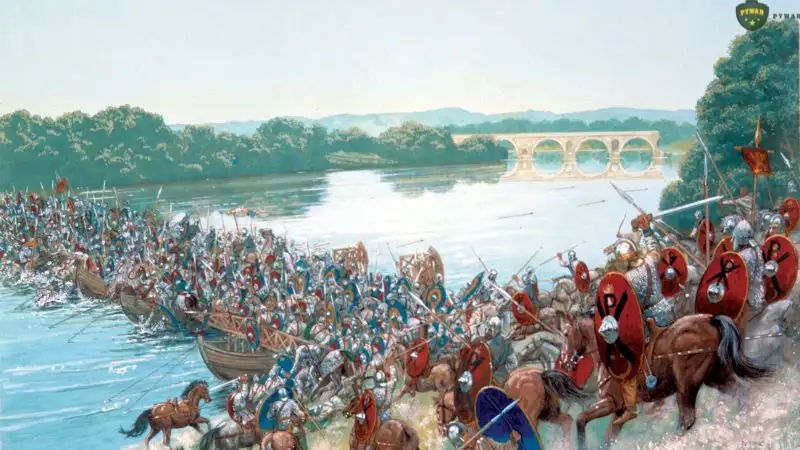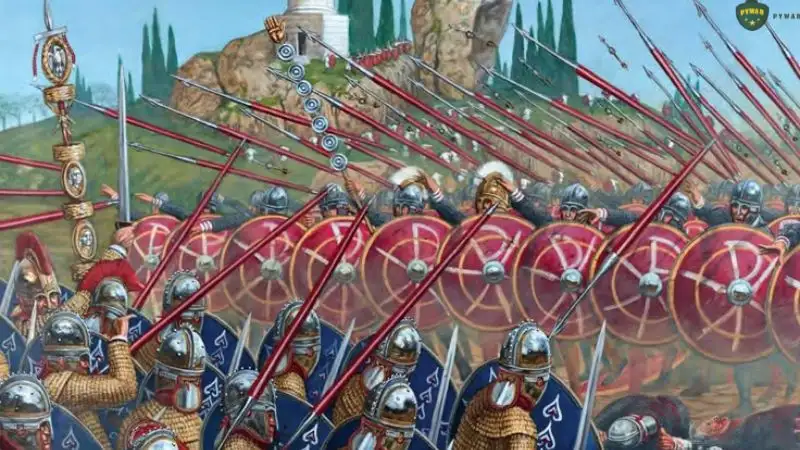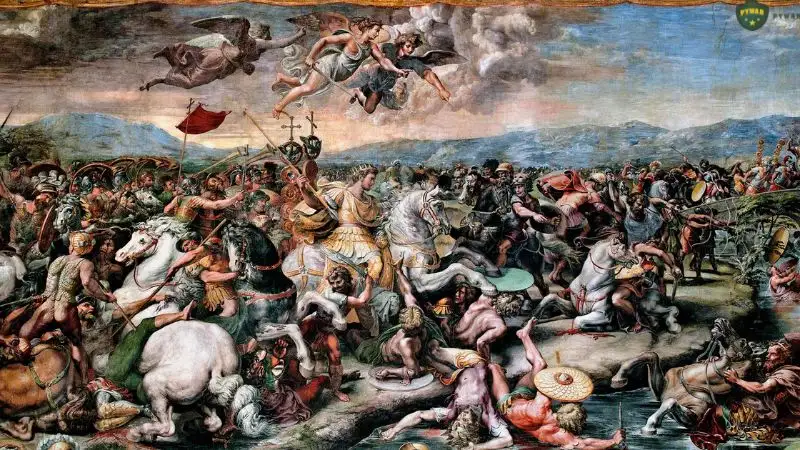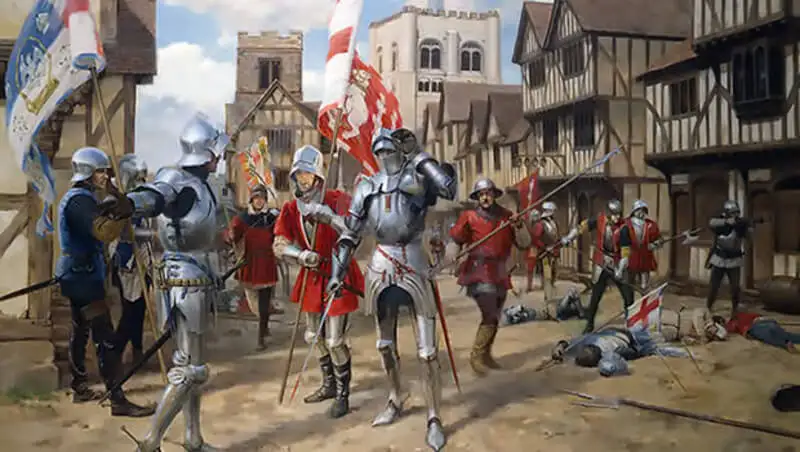The Battle of the Milvian Bridge in 312 AD stands as a pivotal moment in Roman history, marking not only a decisive military triumph for Constantine the Great but also a turning point in the Christianization of Rome. Fought between Constantine I and Maxentius, this Roman battle reshaped the Roman Empire, ushering in the era of Roman Christianity through Constantine’s vision of the Chi Rho symbol and his subsequent conversion to Christianity. This article delves into the Battle of 312, exploring its time, location, causes, course, casualties, and outcome, while weaving in key aspects of Roman military strategy, the Tiber River’s role, and the religious transformation in Rome.
Time and Date of the Battle
The Battle of the Milvian Bridge took place on October 28, 312 AD. The fighting began in the early morning and continued throughout the day, culminating in a decisive victory by late afternoon. This date, recorded in historical sources like Lactantius and Eusebius, is significant for its alignment with Constantine’s military campaign and the religious shift that followed, as symbolized by the Chi Rho and the Labarum standard.

Location of the Battle
The battle was fought at the Milvian Bridge, a critical crossing over the Tiber River, located just north of Rome (city) in modern-day Italy. The Milvian Bridge, constructed in 206 BC, connected the Via Flaminia, a major Roman road, to the city, making it a strategic chokepoint for any army approaching Rome. The battle itself spanned the bridge and the surrounding plains, with the Tiber River in history playing a key role as a natural barrier. Maxentius’s forces were positioned with their backs to the river, limiting their maneuverability, while Constantine’s army approached from the north, leveraging the open terrain for tactical advantage.
Causes of the Conflict
The Milvian Bridge conflict was rooted in the political and military turmoil of the Tetrarchy, the Roman system of divided rule established by Emperor Diocletian in 293 AD. Several factors precipitated the conflict between Constantine and Maxentius:
- Collapse of the Tetrarchy: The Tetrarchy, designed to stabilize the Roman Empire through four co-emperors, began to unravel after Diocletian’s abdication in 305 AD. Constantine I, proclaimed Augustus in the West by his troops in 306 AD, faced rival claims to power. Maxentius, son of former Emperor Maximian, seized control of Rome and Italy, declaring himself emperor in 306 AD, setting the stage for a power struggle.
- Rivalry for Control of Rome: Maxentius’s rule in Rome was marked by unrest, as he faced opposition from the Roman Senate and populace due to heavy taxation and perceived tyranny. Constantine, based in Gaul and Britain, sought to consolidate his authority in the West, viewing Maxentius as an illegitimate usurper. The battle of 312 was the culmination of Constantine’s campaign to capture Rome.
- Religious Tensions: While not the primary cause, religious dynamics played a role. Maxentius maintained traditional Roman pagan practices, while Constantine, influenced by his mother Helena’s Christianity, began to favor Early Christianity. The divine vision of the Chi Rho symbol, reported by Lactantius and Eusebius, occurred before the battle, framing it as a religious as well as political contest.
- Strategic Ambitions: Constantine’s march on Italy in 312 AD aimed to unify the Western Empire under his rule. Maxentius’s control of Rome, the symbolic heart of the empire, made a confrontation inevitable. The Roman military history of this period reflects intense competition among Tetrarchic rulers, with the Milvian Bridge clash as a decisive moment.
These factors converged to make the Battle of the Milvian Bridge a critical showdown for control of the Roman Empire.
Course of the Battle
The Battle of the Milvian Bridge was a meticulously planned engagement, showcasing Constantine’s military campaign and Roman military strategy against Maxentius’s defensive errors. The battle unfolded as follows:
Prelude and Constantine’s Vision
In spring 312 AD, Constantine I launched his campaign from Gaul, crossing the Alps with an army of approximately 40,000 men, including seasoned legions and Germanic auxiliaries. His victories at Turin, Milan, and Verona weakened Maxentius’s hold on northern Italy. According to historical accounts by Lactantius and Eusebius, Constantine experienced a divine vision before the battle, seeing a cross or the Chi Rho symbol (☧, formed from the Greek letters Chi and Rho, representing Christ) in the sky with the words “In hoc signo vinces” (“In this sign, you shall conquer”). Inspired, Constantine ordered his troops to paint the Chi Rho on their shields and adopt the Labarum standard, marking a significant moment in the Christianization of Rome.

Maxentius, with an army of 75,000 to 100,000 men, including the elite Praetorian Guard, prepared to defend Rome. Expecting a siege, he stockpiled supplies and fortified the city. However, fearing unrest in Rome and possibly influenced by misinterpreted omens, Maxentius chose to confront Constantine outside the city walls at the Milvian Bridge.
Battle Deployment
On the morning of October 28, 312 AD, Maxentius positioned his army on the plain north of the Tiber River, with the Milvian Bridge at their rear. He had sabotaged the stone bridge, replacing it with a temporary pontoon bridge to facilitate retreat or resupply, a decision that proved catastrophic. Constantine’s forces approached from the north along the Via Flaminia, deploying in a disciplined formation with heavy infantry at the center, cavalry on the wings, and archers and slingers providing ranged support.
The Engagement
The battle began with skirmishes as Constantine’s cavalry probed Maxentius’s flanks. Maxentius’s larger army, composed of less experienced levies and the battle-hardened Praetorians, initially held firm. However, Constantine’s strategic acumen shone through. His cavalry outmaneuvered Maxentius’s wings, while his infantry, emboldened by the Sign of the Cross, pressed the center. Maxentius’s decision to fight with the Tiber River at his back limited his ability to maneuver, as his troops were funneled toward the narrow pontoon bridge.
As the battle intensified, Constantine’s disciplined legions gained the upper hand, breaking Maxentius’s lines. Panic set in among Maxentius’s forces, and many attempted to flee across the pontoon bridge, which collapsed under the weight of retreating soldiers. Maxentius himself was caught in the chaos, drowning in the Tiber River along with thousands of his men. The fall of Maxentius marked the collapse of his army, with survivors surrendering or fleeing.
Aftermath
By late afternoon, Constantine’s forces secured a decisive victory. The following day, October 29, 312 AD, Constantine entered Rome in triumph, greeted as a liberator. He disbanded the Praetorian Guard, a symbol of Maxentius’s regime, and began consolidating his rule. The victory was commemorated with the Arch of Constantine, dedicated in 315 AD, which still stands in Rome and subtly references his Christian vision. The Edict of Milan in 313 AD, co-issued with Licinius, granted tolerance to Christians, cementing the battle’s role in the religious transformation in Rome.

Casualties
Precise casualty figures for the Battle of the Milvian Bridge are uncertain due to limited contemporary records, but estimates provide insight into the scale of the losses:
- Maxentius’s Forces: Approximately 10,000 to 20,000 killed, with thousands more wounded or captured. The collapse of the pontoon bridge led to significant losses, as many soldiers drowned in the Tiber River. The Praetorian Guard, loyal to Maxentius, was nearly annihilated.
- Constantine’s Forces: Estimates suggest 1,000 to 3,000 casualties, with fewer deaths due to their disciplined tactics and strategic advantage. Constantine’s use of ancient military tactics, including cavalry flanking maneuvers, minimized his losses.
The high casualties on Maxentius’s side, particularly from the river disaster, underscored the battle’s intensity and the strategic errors that led to his defeat.
Who Won the Battle of the Milvian Bridge
The Battle of the Milvian Bridge was won by Constantine the Great. His decisive victory over Maxentius on October 28, 312 AD, secured control of Rome and marked a turning point in the Roman Empire. The victory at the Milvian Bridge eliminated Maxentius as a rival, paving the way for Constantine’s rise to sole Western emperor and the subsequent spread of Christianity across the empire. The battle’s religious significance, tied to Constantine’s vision and the Chi Rho symbol, solidified its place as a transformative event in Roman historical event history.

Conclusion
The Battle of the Milvian Bridge, fought on October 28, 312 AD, was a watershed moment in Roman history, blending military triumph with profound religious change. Driven by the collapsing Tetrarchy, the rivalry between Constantine I and Maxentius, and the strategic importance of Rome, the Milvian Bridge clash showcased Constantine’s military campaign and Roman military strategy. The battle’s outcome, with heavy losses for Maxentius’s forces and the drowning of Maxentius in the Tiber River, marked Constantine’s victory and the beginning of the Christianization of Rome.
The Edict of Milan and the Arch of Constantine later commemorated this triumph, which reshaped the empire’s religious and political landscape. For historians and enthusiasts, the Battle of 312 offers a compelling study of Early Christianity, divine vision, and the interplay of military and spiritual forces in shaping the Roman Empire.




